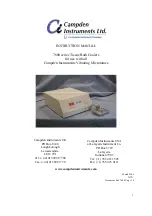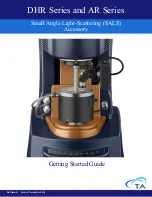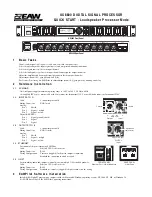
dual-waveform, voltage-controlled oscillator which frequency-modulates the carrier
oscillator. This enables you to move the sum and difference frequencies toward and
away from each other at speeds from one cycle every ten seconds, to 25 times a
second, with either a square wave or a sine-like wave contour.
To hear the effect of changing the carrier oscillator frequency, first set up your MF-102
as follows:
AMOUNT
4
RATE
0.1
MIX
10
FREQUENCY
120/2.5
Left Switch
sine waveform
Right Switch
HI
Connect your instrument and monitor amp to your MF-102, set the stomp switch so the
BYPASS light is green, and play a few simple, sustained notes. You will hear the sum and
difference frequencies slowly drifting apart, and then together, once every ten seconds
or so. This is the result of the 0.1 Hz LFO triangular wave modulating the carrier oscillator
frequency. The setting of the AMOUNT knob determines how much the carrier oscillator
is being frequency-modulated, while the setting of the RATE knob varies the LFO
frequency. Experiment with these two controls to hear the effect of the LFO over its
entire range. Then set the left switch to square waveform to hear the difference
between the two LFO waveforms.
TOURING THE PANEL FEATURES
The LFO Section
Let's look at the LFO section first. The two control knobs are AMOUNT and RATE. In
addition, there is a “square-sine” waveform switch. The LFO light shows the speed at
which the LFO is oscillating.
The AMOUNT knob determines the amount of LFO waveform that frequency-
modulates the carrier oscillator. When the knob is counterclockwise, there is no
frequency modulation by the LFO. When the knob is fully clockwise, the carrier oscillator
is frequency-modulated over a range of three octaves.
The RATE determines how fast the LFO oscillates. The knob spans the frequency range
of 0.1 Hz (one cycle every ten seconds) to 25 Hz.
The “square-sine” waveform switch selects either the square waveform or the sine-like
waveform that the LFO produces. The square wave produces trill effects, whereas the
sine waveform produces vibrato and siren effects.
The LFO light is illuminated by the sine LFO waveform. You can use it to get a visual
indication of the LFO’s speed.
The Modulator Section
The MIX knob, the FREQUENCY knob, and the LO-HI switch are all part of the

































